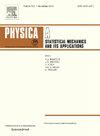标准化时间分数Fokker-Planck方程的计算分析
IF 2.8
3区 物理与天体物理
Q2 PHYSICS, MULTIDISCIPLINARY
Physica A: Statistical Mechanics and its Applications
Pub Date : 2025-03-08
DOI:10.1016/j.physa.2025.130500
引用次数: 0
摘要
我们提出了一个标准化的时间分数Fokker-Planck方程。采用有限差分法建立了求解该方程的计算方法,并通过计算仿真研究了系统的动力学特性。所提出的模型在逼近解析解方面具有准确性和效率。数值试验验证了该方法的有效性,并突出了不同分数阶对归一化时间分数Fokker-Planck方程动力学的影响。数值试验强调了不同分数阶对系统时间演化的显著影响。具体来说,计算结果表明分数阶的变化如何影响扩散过程,低阶表现出更强的记忆效应和更慢的扩散,而高阶导致更快的传播和向经典扩散行为的过渡。这项工作有助于理解分数动力学,并为模拟时间分数系统提供了一个强大的工具。本文章由计算机程序翻译,如有差异,请以英文原文为准。
Computational analysis of a normalized time-fractional Fokker–Planck equation
We propose a normalized time-fractional Fokker–Planck equation (TFFPE). A finite difference method is used to develop a computational method for solving the equation, and the system’s dynamics are investigated through computational simulations. The proposed model demonstrates accuracy and efficiency in approximating analytical solutions. Numerical tests validate the method’s effectiveness and highlight the impact of various fractional orders on the dynamics of the normalized time-fractional Fokker–Planck equation. The numerical tests emphasize the significant impact of different fractional orders on the temporal evolution of the system. Specifically, the computational results demonstrate how varying the fractional order influences the diffusion process, with lower orders exhibiting stronger memory effects and slower diffusion, while higher orders lead to faster propagation and a transition towards classical diffusion behavior. This work contributes to the understanding of fractional dynamics and provides a robust tool for simulating time-fractional systems.
求助全文
通过发布文献求助,成功后即可免费获取论文全文。
去求助
来源期刊
CiteScore
7.20
自引率
9.10%
发文量
852
审稿时长
6.6 months
期刊介绍:
Physica A: Statistical Mechanics and its Applications
Recognized by the European Physical Society
Physica A publishes research in the field of statistical mechanics and its applications.
Statistical mechanics sets out to explain the behaviour of macroscopic systems by studying the statistical properties of their microscopic constituents.
Applications of the techniques of statistical mechanics are widespread, and include: applications to physical systems such as solids, liquids and gases; applications to chemical and biological systems (colloids, interfaces, complex fluids, polymers and biopolymers, cell physics); and other interdisciplinary applications to for instance biological, economical and sociological systems.

 求助内容:
求助内容: 应助结果提醒方式:
应助结果提醒方式:


